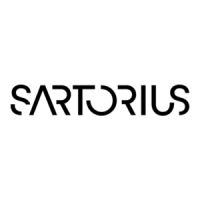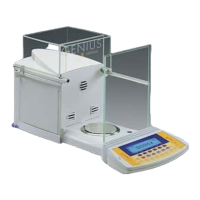Do you have a question about the Sartorius GPA5202-OCE and is the answer not in the manual?
General guidelines for safe operation and equipment handling to prevent damage.
Important considerations before and during balance installation, including voltage and cable checks.
Detailed list of all items provided with the balance package for various models.
Guidelines for handling the balance during transport and storage to avoid damage.
Steps for safely unpacking the balance and checking for any external damage.
Criteria for choosing a suitable location, avoiding heat, drafts, and vibrations.
Procedure for acclimatizing the balance to room temperature after transport.
Explanation of the control seal for verified balances used in legal metrology.
Steps for setting up the CPA2P model, including draft shield and weighing pan.
Setup for CPA2P-F with filter pans and standard weighing pans.
Instructions for correctly positioning the analytical draft shield on the balance.
Identification and explanation of the balance's display symbols and control keys.
Explains the use and capabilities of the basic weighing mode, including taring.
Requirements for using balances as legal measuring instruments, including calibration.
Tips for steady handling and test measurements specific to microbalances.
Procedure for performing below-balance weighing on analytical and precision models.
Steps for setting up below-balance weighing on the CPA2P microbalance.
Defines calibration/adjustment and outlines prerequisites and features.
Requirements for internal calibration/adjustment for legal metrology use.
Details on performing external calibration for accuracy class II balances.
Adapting the balance to individual requirements by selecting options in the Setup menu.
Instructions on how to print current balance configuration settings.
Example of setting parameters for 'very unstable' ambient conditions via menu code.
Settings related to filter, stability, tare, and weight units.
Configuration for CAL key function, calibration sequence, and isoCAL.
Selection and configuration of application programs like counting and weighing.
Configuring measurement environment parameters for records and display settings.
Navigation and input controls for setting IDs, time, date, and display brightness.
Describes the role of F and CF keys in starting, toggling, and ending application programs.
How application programs function with verified measuring instruments and display symbols.
Weighing components to a defined total, storing, clearing data, and toggling views.
Determining part count by weighing a reference sample quantity.
Keys for initiating piece weight determination and changing reference sample quantity.
Obtaining weight readouts as a percentage of a reference weight.
Keys for calculating percentage and changing reference percentage values.
Determining weights of unstable samples by averaging multiple operations.
Keys for activating the program and changing the number of subweighing operations.
Switching the display between two configured weight units.
Using the F key to toggle between the selected weight units.
Creating printouts with weights, values, and IDs for documentation.
Settings for line format, application parameters, ISO/GLP, and auto print.
Connecting the balance to computers or peripherals via a serial RS-232 interface.
Default interface settings and steps to prepare for connection.
How non-verified digits are identified on printouts, typically with brackets.
Sending commands via the interface to control balance functions and applications.
Pin configuration for the female and male interface connectors.
Cautionary note regarding incorrect pin assignments on third-party RS-232 cables.
Detailed list of pin functions for the 25-pin D-Submini interface connector.
Visual representation of connections for linking a computer or peripheral device.
Lists common display errors, their causes, and recommended solutions.
Steps for safely removing components and packing the balance for shipping.
Information on service contracts, authorized repairs, and cautions.
Instructions for cleaning the balance housing, display, and stainless steel surfaces.
Detailed steps for cleaning the weighing chamber and removable draft shield parts.
Guidelines for checking balance safety and when to contact service.
Information on proper disposal of the equipment, packaging, and batteries.
Detailed technical data and specifications for CPA2P and CPA2P-F models.
List of available optional accessories with their respective order numbers.
EU directives and regulations for weighing instruments used in legal metrology.
Details on EC verification services and the validity of type-approval certificates.
Identification and explanation of the various labels and plates on the balance.
General guidelines for safe operation and equipment handling to prevent damage.
Important considerations before and during balance installation, including voltage and cable checks.
Detailed list of all items provided with the balance package for various models.
Guidelines for handling the balance during transport and storage to avoid damage.
Steps for safely unpacking the balance and checking for any external damage.
Criteria for choosing a suitable location, avoiding heat, drafts, and vibrations.
Procedure for acclimatizing the balance to room temperature after transport.
Explanation of the control seal for verified balances used in legal metrology.
Steps for setting up the CPA2P model, including draft shield and weighing pan.
Setup for CPA2P-F with filter pans and standard weighing pans.
Instructions for correctly positioning the analytical draft shield on the balance.
Identification and explanation of the balance's display symbols and control keys.
Explains the use and capabilities of the basic weighing mode, including taring.
Requirements for using balances as legal measuring instruments, including calibration.
Tips for steady handling and test measurements specific to microbalances.
Procedure for performing below-balance weighing on analytical and precision models.
Steps for setting up below-balance weighing on the CPA2P microbalance.
Defines calibration/adjustment and outlines prerequisites and features.
Requirements for internal calibration/adjustment for legal metrology use.
Details on performing external calibration for accuracy class II balances.
Adapting the balance to individual requirements by selecting options in the Setup menu.
Instructions on how to print current balance configuration settings.
Example of setting parameters for 'very unstable' ambient conditions via menu code.
Settings related to filter, stability, tare, and weight units.
Configuration for CAL key function, calibration sequence, and isoCAL.
Selection and configuration of application programs like counting and weighing.
Configuring measurement environment parameters for records and display settings.
Navigation and input controls for setting IDs, time, date, and display brightness.
Describes the role of F and CF keys in starting, toggling, and ending application programs.
How application programs function with verified measuring instruments and display symbols.
Weighing components to a defined total, storing, clearing data, and toggling views.
Determining part count by weighing a reference sample quantity.
Keys for initiating piece weight determination and changing reference sample quantity.
Obtaining weight readouts as a percentage of a reference weight.
Keys for calculating percentage and changing reference percentage values.
Determining weights of unstable samples by averaging multiple operations.
Keys for activating the program and changing the number of subweighing operations.
Switching the display between two configured weight units.
Using the F key to toggle between the selected weight units.
Creating printouts with weights, values, and IDs for documentation.
Settings for line format, application parameters, ISO/GLP, and auto print.
Connecting the balance to computers or peripherals via a serial RS-232 interface.
Default interface settings and steps to prepare for connection.
How non-verified digits are identified on printouts, typically with brackets.
Sending commands via the interface to control balance functions and applications.
Pin configuration for the female and male interface connectors.
Cautionary note regarding incorrect pin assignments on third-party RS-232 cables.
Detailed list of pin functions for the 25-pin D-Submini interface connector.
Visual representation of connections for linking a computer or peripheral device.
Lists common display errors, their causes, and recommended solutions.
Steps for safely removing components and packing the balance for shipping.
Information on service contracts, authorized repairs, and cautions.
Instructions for cleaning the balance housing, display, and stainless steel surfaces.
Detailed steps for cleaning the weighing chamber and removable draft shield parts.
Guidelines for checking balance safety and when to contact service.
Information on proper disposal of the equipment, packaging, and batteries.
Detailed technical data and specifications for CPA2P and CPA2P-F models.
List of available optional accessories with their respective order numbers.
EU directives and regulations for weighing instruments used in legal metrology.
Details on EC verification services and the validity of type-approval certificates.
Identification and explanation of the various labels and plates on the balance.











